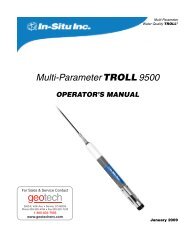TEST INSTRUCTIONS - Geotech Environmental Equipment
TEST INSTRUCTIONS - Geotech Environmental Equipment
TEST INSTRUCTIONS - Geotech Environmental Equipment
You also want an ePaper? Increase the reach of your titles
YUMPU automatically turns print PDFs into web optimized ePapers that Google loves.
LEAD<br />
PAR METHOD CODE 4031<br />
QUANTITY CONTENTS CODE<br />
250 mL Ammonium Chloride Buffer 4032-K<br />
15 mL *Sodium Cyanide, 10% *6565-E<br />
30 mL PAR Indicator 4033-G<br />
30 mL Stabilizing Reagent 4022-G<br />
15 mL DDC Reagent 4034-E<br />
1 Syringe, 5 mL, plastic 0807<br />
2 Pipet, 0.5 mL, plastic 0353<br />
*WARNING: Reagents marked with an * are considered hazardous substances. To<br />
view or print a Material Safety Data Sheet (MSDS) for these reagents see MSDS CD<br />
or our web site. To obtain a printed copy, contact us by e-mail, phone or fax.<br />
The average concentration of lead is 0.003 ppm in streams and less than 0.1<br />
ppm in groundwater. Lead in a water supply may come from mine and smelter<br />
discharges or from industrial waste. Lead is used in the production of batteries,<br />
solder, pigments, insecticides, ammunition and alloys. Tetraethyl Lead has been<br />
used for years as an anti-knock reagent in gasoline. Lead may also enter water<br />
supplies when corrosive water dissolves pipes, plumbing fixtures and materials<br />
containing lead. Lead accumulates in the body and is toxic by ingestion.<br />
APPLICATION: Drinking and surface waters; domestic and industrial<br />
wastewater.<br />
RANGE: 0.00–5.00 Lead<br />
METHOD: Lead and calcium ions form a red complex with PAR<br />
(4- 2’-pyridylazo resorcinol), at a pH of about 10. When<br />
sodium diethyldithiocarbamate is added, the lead/PAR<br />
complex is destroyed leaving the calcium/PAR complex. The<br />
difference between the two measurements is due to the lead<br />
concentration.<br />
SAMPLE Analyze sample as soon as possible. If sample must be stored,<br />
HANDLING &<br />
PRESERVATION:<br />
acidify with nitric acid to a pH of below 2.<br />
INTERFERENCES: Calcium greater than 100 ppm (250 ppm CaCO3) will<br />
interfere. Low concentrations of cerium, iron, manganese,<br />
magnesium, sulfur, tin, and EDTA will also interfere.<br />
Smart2 <strong>TEST</strong> PROCEDURES 2.04 Lead 1/2

















